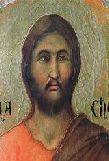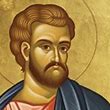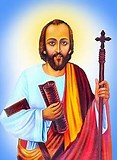

Holy Trinity
Amblecote
The Twelve Apostles
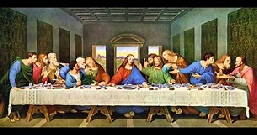
The Twelve Apostles, (an apostle is somebody sent forth/sent out) were men that, according to the Synoptic Gospels (Matthew, Mark and Luke) and Christian tradition, were chosen from among the disciples of Jesus for a mission.
Simon (Peter)
His original name was Simeon or Simon and he was recognized by the early Christian church as the leader of the 12 disciples and by the Roman Catholic Church as the first of its Popes. Peter, who was a Jewish fisherman, was called to be a disciple of Jesus at the beginning of His ministry. Jesus gave him the name Peter (the Rock). Although his death is not Scriptural, numerous writers described his death as having occurred in Rome during the reign of the Emperor Nero in 64 AD. According to tradition, Peter was crucified upside down because he felt unworthy to die in the same manner as Jesus.

Andrew
Andrew was the brother of Simon Peter. He was the first apostle Jesus called and the first apostle to claim Jesus was the Messiah. He comes onto the scene early in the gospels, but only plays a minor role. However, his prominence in the lists of disciples and the few glimpses we get of him seem to suggest he was one of the main apostles -
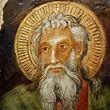
In Matthew and Mark Jesus first encounters Andrew when he’s fishing near the shore of the Sea of Galilee with Peter.
The Gospel of John however claims that Andrew followed Jesus before any of the other apostles.
Tradition holds that Andrew was martyred by crucifixion in the Greek city of Patras around 60 AD. Like his brother, Peter, Andrew allegedly didn’t consider himself worthy to die in the same way as Jesus, and tradition claims he was bound -
Matthew was also known as Levi and is traditionally regarded as the author of the Gospel of Matthew. When Jesus called Matthew to follow him he was a tax collector (or “publican”) -
Little is known about this apostle. Aside from a handful of mentions in the gospels, he is a surprisingly obscure New Testament figure. Despite the fact that the church has long considered him the author of the Gospel of Matthew little else was ever recorded about him.
While Matthew is honoured as a martyr no one knows for sure where or how he died. Various accounts say he was beheaded, stoned, burned, or stabbed -
Matthew

Mark
Mark was born in the Pentapolis or Qairawan (Now Tunisia or Libya) it is believed approximately 15 years after Jesus was born. He witnessed His preaching in Palestine as well as His passion. He is the author of the earliest Gospel to be written (in Greek). He was the founder of Christianity in Egypt or in Alexandria at least. He came to Alexandria in approximately 48 AD. He was martyred in 68 AD when pagans of Serapis (the Serapion-
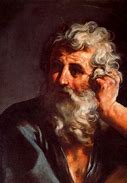




Philip
Three Gospels list Philip as one of the apostles. John describes him as a disciple from the city of Bethsaida, and connects him with Andrew and Peter, who were from the same town. He also was among those surrounding John the Baptist when John first pointed out Jesus as the Lamb of God. It was Philip who first introduced Nathanael (sometimes identified with Bartholomew) to Jesus. Of the four Gospels Philip figures most prominently in the Gospel of John. Jesus is asked by Philip how to feed the 5,000 people. Later he appears as a link to the Greek community. Philip bore a Greek name and may well have spoken Greek.

During the Last Supper, when Philip asked Jesus to show them the Father, he gives Him the opportunity to teach his disciples about the unity of the Father and the Son.
One tradition claims that he died of natural causes and yet another that he was crucified.

Bartholomew
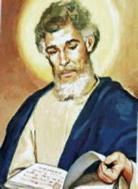
Bartholomew was one of the disciples who pretty much stayed in the background. Not much is known about Bartholomew’s life before and during Jesus’ ministry, and most of what we can glean about his life after the Lord’s death were based on the accounts of other writers. The 4th-

James (The Great)
James, son of Zebedee, or James the Greater, was born in Galilee and died in 44AD in Jerusalem. He was one of those Apostles distinguished as being in Jesus’ innermost circle and the only apostle whose martyrdom is recorded in the New Testament in the book of Acts. James’ death was the result of being beheaded. “About that time Herod the king laid violent hands on some who belonged to the church. He killed James the brother of John with the sword”. James is described as one of the first disciples to join Jesus. The Synoptic Gospels say that James and John were with their father by the seashore when Jesus called them to follow him.

J ames (The Lesser)
ames (The Lesser)
James son of Alphaeus is only recorded in the New Testament in the four lists of disciples, and always toward the end, indicating possibly that he was less important than the others. James son of Alphaeus is traditionally identified as James the Less and James the brother of Jesus. There is a claim that he was martyred in Persia but this is generally considered by most scholars to be unlikely.

Simon (The Zealot)
No specific stories surrounding the apostle Simon appear in the Bible, nor are any quotes of his recorded. He is merely listed as an apostle, although in two different ways. Matthew and Mark call him the “Cananean” while Luke identifies Simon as a “Zealot”. He was commissioned to go out to various towns to preach and heal. He probably attended the Last Supper (but possibly not the Crucifixion). He saw the risen Jesus, observed His ascension into heaven, and received the Holy Spirit. Some claim that after Pentecost he travelled extensively to spread the message of Christ.
Others wrote that he preached in Syria, Egypt, Britain, Mesopotamia, and Persia. While in Mesopotamia, Simon reportedly met up with Jude Thaddeus. The two apostles are alleged to have travelled to Persia (Iran) and there taught of the life of Jesus. Their words and actions were so convincing that thousands of Persians converted to Christianity. However, after some time, the two were martyred there. Simon by being sawn into pieces.

Jude (Thaddaeus)
Jude was a brother of James the Less and a relative of Jesus. Biblical scholars agree Jude was a son of Clopas and his mother Mary was the Virgin Mary's cousin. Ancient writers tell us that he preached the Gospel in Judea, Samaria, Idumaea, Syria, Mesopotamia, and Lybia. According to Eusebius, he returned to Jerusalem in the year 62, and assisted at the election of his brother, Simeon, as Bishop of Jerusalem. Jude asked Jesus at the Last Supper why He would not manifest Himself to the whole world after His resurrection. Little else is known of his life. Legend claims that he visited Beirut and Edessa and he was martyred by being clubbed to death when with Simon in Persia.

Thomas
Thomas was also called Didymus ("twin"). Thomas is commonly known as "Doubting Thomas" because he doubted Jesus' resurrection when first told of it (only in John’s Gospel). Later he confessed his faith, "My Lord and my God," on seeing Jesus' crucifixion wounds. While Thomas' character is mentioned in the other gospels, only the Gospel of John develops his character. He is not always able to understand the meaning of some of the teaching of Jesus and is often seen questioning him directly. After the Crucifixion it is believed that Thomas ministered in Parthia, Persia, and India. He was martyred for his faith by being run through with a spear.
Judas Iscariot

Not much is known about Judas’s childhood and early life. His surname, “Iscariot,” indicates that he came from the town of Kerioth (also known as Carioth) in Judaea. He was the son of Simon Iscariot.
He studied under Jesus for three years and was very close to Jesus and became part of his innermost circle. He was said to be a healer of the sick and a performer of exorcisms (casting out demons), apart from being a preacher of the gospel. He was made the treasurer of the group by Jesus and John’s Gospel says the disciples’ money box was kept in his custody.
According to Matthew he betrayed Jesus in exchange of a bribe of 30 pieces of silver from the Jewish priests. According to this gospel, he identified Jesus with a kiss and revealed him to the soldiers of the Jewish high priest Joseph Caiaphas, who then handed Jesus over to the soldiers of the Roman governor of Judaea, Pontius Pilate. The gospel also states that Jesus foresaw that Judas would betray him.
There are various accounts of his death. Matthew says that Judas was filled with regret and remorse after betraying Jesus and that he went to return the 30 pieces of silver to the priests. They refused to accept the money as it was blood money. He threw the 30 pieces of silver away and left. He then committed suicide by hanging himself.
The book of the Acts of the Apostles, written much later, says that Judas had bought a field with the money he received from the priests and that as he walked through the field he fell on his head and died.
Acknowledgements:
The Catholic Encyclopaedia.
wikipedia.org. overviewbible.com.
learnreligions.com. britannica.com.
whatchristianswanttoknow.com.
Google images
and other Internet sources.

